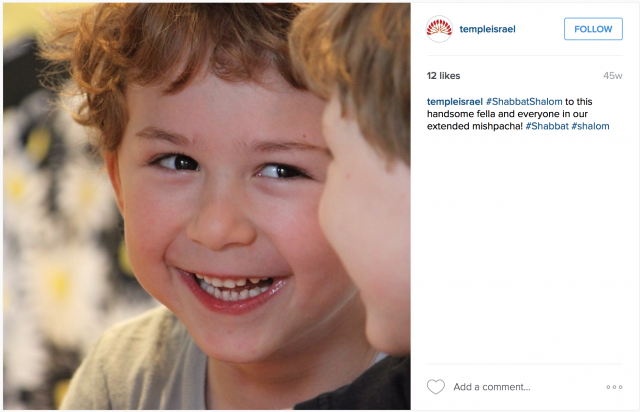Editors note: We often use this blog to highlight the wisdom and experience of those within our network. Isti Bardos is the Communications Director at Temple Israel in Memphis. On a recent webinar he was giving great advice to those getting started on Instagram, and we asked him to share some tips that make his Instagram efforts successful.
A picture is worth…Yup. We all know.
I would argue, however, that pictures – and videos – are worth much more than words, 1,000 or not. Imagery evokes feelings, creates empathy and fosters meaningful, lasting relationships. Isn’t that what our work in congregations is all about: building community and lasting relationships?
By sharing highlights and snippets of everyday life through Instagram, you are illustrating how your congregation is a community of meaning and purpose, not only an institution with "tushes in seats". While some people may feel nervous about showing photos of people in your congregation, Instagram (and the sharing culture) is happening with or without you. Be thoughtful about releases in your membership and registration materials (and avoid those who don't want their photos shared), but also recognize that many of the ever-so-coveted 20s/30s demographic are prolifically sharing their photos (and wanting to see those of others). A full 90% of those using Instagram are 35 or younger (data as of June, 2015 — older demographics are beginning to flock to Instagram too).
In addition to engaging the younger demographic, Instagram is a worthy social media platform because
1) It's in your congregation’s best interests to put your best face – literally and figuratively — out there!
2) Participating in Instagram a way to “show off” your congregation.
3) It's good to show a wide array of smiling faces, activities, and slices of life of your congregation!
4) By using Instagram, your congregation will be perceived as hip and modern, on top of the newest technologies.
Two questions people often ask are:
1) What should we post?
2) How often should we post?
To me, the answers are the same: Post good content when you have it. But make a point of integrating great photography (on your phone!) into your routine so you have content at least a couple times a week.
#SHABBATSHALOM
If you don’t know where to start, start with a #ShabbatShalom message every Friday afternoon. (That # symbol, in today’s social media vernacular, is a hashtag. Hashtags allow you to search for items. For example, if you used the hashtag #ShabbatShalom, you would see only photos/videos from around the world that have that hashtag associated with it, which is pretty cool.)
 So, simply take a photo of a smiling child at religious school. While the culture of Instagram is to post photos immediately after they are taken, you can also have some "timeless" images that can be saved for a Friday post. With these #ShabbatShalom postings, you will be sharing a photo at least once a week!
So, simply take a photo of a smiling child at religious school. While the culture of Instagram is to post photos immediately after they are taken, you can also have some "timeless" images that can be saved for a Friday post. With these #ShabbatShalom postings, you will be sharing a photo at least once a week!
#TBT
Another example which could guarantee another weekly post, is #tbt. #tbt stands for “throwback Thursday.” It’s simply an easy way for you to post a video or photo of something that happened in the past, whether it was a year or 100 years ago. This could be a childhood photo of your rabbi, or a memorable event in your congregation's past, like this picture from our congregation's 2008 trip to Israel.
So between #ShabbatShalom and #tbt, you already have guaranteed yourself at least two compelling Instagram posts a week, which a great start!
But you have an endless supply of other good, compelling content — here are some ideas and examples from our congregation:
• volunteers
• staff
• families
• events/programs
• women’s and men’s clubs
• beautiful facilities/campus
• religious/Hebrew school tutors/teachers
• different segments of your congregation
• creative snapshots of congregational life
• and, of course, smiling children
By the way, it’s important to use photo of people who are smiling, because smiling… is a cause of happy feelings! …is contagious! …can make you healthier! …can be a predictor of how long you’ll live! But also remember that Instagram's community values really great photography, including abstract shots of mundane things, insights into everyday moments, bold color and gorgeous patterns. Like this photo of Hamentashen from OU Hillel.
Also, there is a sense of immediacy and connectivity with Instagram. For example, what is more interesting and interactive: reading – a month after the fact in a black and white newsletter – the sentence “Students watched a science demonstration involving Mentos and Diet Coke” or watching a 10-second video clip of a “volcano” erupting a few minutes after the event took place – and then having the ability to provide immediate feedback?
Posting photos and videos to Instagram is less about the information and more about making emotional connections. As people scroll through their Instagram feed, make sure that your congregation has a presence! Scroll through your Instagram feed periodically to see the "bigger picture" that new followers might find if they look at everything you've posted recently.
If your congregation doesn’t use Instagram, start using it today. If you have an Instagram account, step your game up! After all, if your congregation REALLY IS a vibrant, warm and welcoming congregational family, then SHOW IT!
Isti Bardos is Communications Director at Temple Israel in Memphis, Tennessee.







 Given the power of online videos, we inaugurated LBTV Action News as a vehicle for telling the school’s story. In 60 to 90 second installments, students did standup spot “news reports,” on selected events and subjects. It was effective in terms of growing our social media reach. Parents are our main audience on Facebook – which is our main social medium — and they love seeing children doing the presenting as well as being the subjects of a video. It lent an additional appeal, as opposed to watching the expected administrator or teacher talking head tell about the school. And they were eager to share the Facebook postings, as well. Some of our most shared and far-reaching videos on Facebook were LBTV Action News items.
Given the power of online videos, we inaugurated LBTV Action News as a vehicle for telling the school’s story. In 60 to 90 second installments, students did standup spot “news reports,” on selected events and subjects. It was effective in terms of growing our social media reach. Parents are our main audience on Facebook – which is our main social medium — and they love seeing children doing the presenting as well as being the subjects of a video. It lent an additional appeal, as opposed to watching the expected administrator or teacher talking head tell about the school. And they were eager to share the Facebook postings, as well. Some of our most shared and far-reaching videos on Facebook were LBTV Action News items.